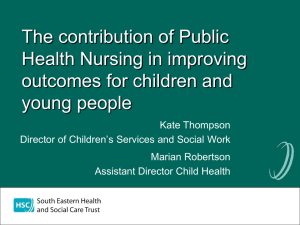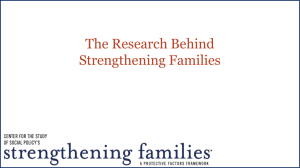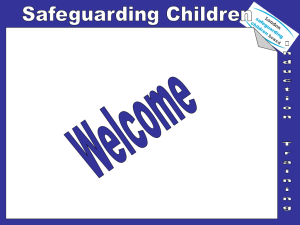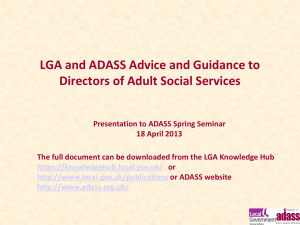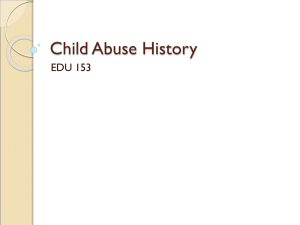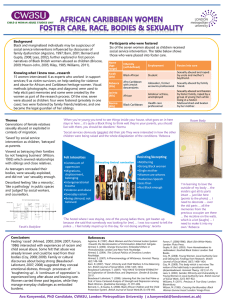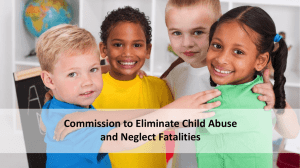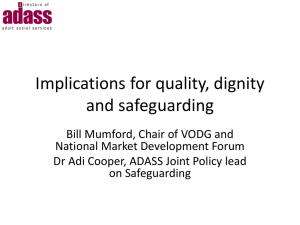Safeguarding Children
advertisement
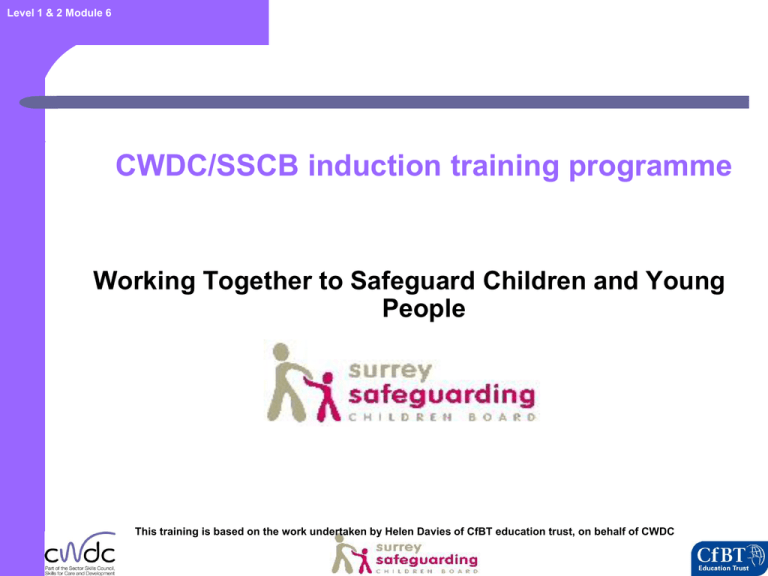
Level 1 & 2 Module 6 CWDC/SSCB induction training programme Working Together to Safeguard Children and Young People This training is based on the work undertaken by Helen Davies of CfBT education trust, on behalf of CWDC Level 1 & 2 Module 6 Overview of the CWDC training modules 1 1. Understanding the principles and values essential for working with children and young people 2. Understanding your role as a worker 3. Understanding health and safety requirements 4. Knowing how to communicate effectively 5. Understanding the development of children and young people 6. Safeguarding Children 7. Developing yourself Level 1 & 2 Module 6 Housekeeping Venue 2 Level 1 & 2 Module 6 Learning Principles 3 The child’s welfare is paramount Everyone’s contribution is of equal value Challenge views and opinions not the person Do not make assumptions in terms of age, gender, sexuality, culture, disability or religion Respect and value diversity Respect different learning styles Ensure confidentiality and safety Encourage full participation Level 1 & 2 Module 6 Activity 1: Introductions 4 • Change seats to sit next to someone you do not know or work with • Introduce yourselves and your role in safeguarding children • Introduce your partner to the group Level 1 & 2 Module 6 Aim 5 To provide participants with the opportunity to develop awareness of what to do if they have concerns about the safety and welfare of children and young people Level 1 & 2 Module 6 Learning Outcomes 6 By the end of the training participants should be able to: • Identify laws and national guidance relating to safeguarding children • Describe what children and young people want and need to feel safe • Identify some of the main forms, signs and effects of abuse • Explain what multi-agency working means for individuals and their work environment • Describe what individuals need to do about reporting concerns, including “whistleblowing” in their own work setting. Level 1 & 2 Module 6 Activity 2 : What do children need to be safe? 7 • In groups discuss what children need to be safe and to promote their welfare? • List on flip chart paper • Be prepared to feed back to whole group Level 1 & 2 Module 6 What children want from professionals 8 Comfortable with sharing information Build up trust Listen to their wishes & feelings To be kept informed Given time to make choices Gain consent Services nonstigmatised Level 1 & 2 Module 6 Every Child Matters Outcomes 9 The Every Child Matters agenda focuses on ensuring that all children and young people have the opportunity to achieve the five outcomes that are key to their well being in childhood and later life. ¨ Level 1 & 2 Module 6 Five Outcomes • Be healthy • Stay safe • Make a positive contribution • Enjoy and achieve • • Achieve economic well being 10 Level 1 & 2 Module 6 Who has responsibility for safeguarding and protecting children? 11 Some people have specific responsibilities, but everyone who works with children and young people has a part to play in helping to keep children and young people safe. All practitioners have a role to play in supporting children to achieve the 5 every child matters outcomes – which includes ‘stay safe’. Level 1 & 2 Module 6 Safeguarding promoting welfare and child protection 12 • Protecting children from maltreatment • Preventing impairment of children’s health or development • Ensuring that children are growing up in circumstances consistent with the provision of safe and effective care • Undertaking that role so as to enable those children to have optimum life chances and to enter adulthood successfully Level 1 & 2 Module 6 Child Protection 13 Is part of safeguarding and promoting welfare. This refers to the activity that is undertaken to protect specific children who are suffering or likely to suffer significant harm Level 1 & 2 Module 6 Activity 3: Core Safeguarding Documents 14 • Each group will be given some legislation and guidance cards • Working together place the cards in a time line placing the earliest first. Level 1 & 2 Module 6 Core Safeguarding Documents 15 • Working Together to Safeguard Children: A guide to interagency working to safeguard and promote the welfare of children (2010) • Children and Young People’s Plan: Building Brighter Futures (2008) • What to do if you’re worried a child is being abused (2006) • The National Service Framework for Children and Young People and Maternity Services (2004) • Common Assessment Framework (2006) • Safeguarding Children and Safer Recruitment in Education (2006) These core documents relate to the Every Child Matters agenda Level 1 & 2 Module 6 Legislation Children Act 1989 Education Act 2002 Children Act 2004 16 Level 1 & 2 Module 6 What is Abuse and Neglect? 17 Somebody may abuse or neglect a child by • inflicting harm, or • failing to act to prevent harm. Children may be abused in a family or in an institutional or community setting; by those known to them or, more rarely, by a stranger for example via the internet. They may be abused by an adult /adults or another child or children. Level 1 & 2 Module 6 Categories of Abuse and Neglect • Physical Abuse • Emotional Abuse (including Domestic Abuse) • Sexual Abuse • Neglect 18 Level 1 & 2 Module 6 Activity 4: Recognising Abuse 19 • In groups list the signs and behaviours in a child or young person that may indicate they are experiencing abuse or neglect. • In addition consider any signs or behaviours that parents/carers may display that would indicate a child or young person may be experiencing abuse or neglect. • Each group will be given a different category of abuse or neglect. Level 1 & 2 Module 6 Signs of abuse 20 The following non-specific signs may indicate something is wrong: • Significant change in behaviour • Extreme anger or sadness • Aggressive and attention-seeking behaviour • Suspicious bruises with unsatisfactory explanations • Lack of self-esteem • Self-injury • Depression • Age inappropriate sexual behaviour Level 1 & 2 Module 6 Possible indicators of abuse in parenting 21 Domestic Abuse Highly mobile families Alcohol Misuse Living in poor conditions Drug Misuse Criminality Mental Health Illness Poor or negative family support Frequent missed appointments (especially health ) Un co-operative with services Level 1 & 2 Module 6 Vulnerability 22 Children may be more vulnerable to being harmed if they are: • • • • • Babies Disabled Children who are picked on as being different Children who are already thought of as a problem e.g. children in care or in secure accommodation Children who are privately fostered Level 1 & 2 Module 6 Additional Indicators for Disabled Children 23 • Force feeding • Unjustified or excessive physical restraint • Rough handling • • Extreme behaviour modification (Deprivation of liquid, medication, food or clothing) • Misuse of medication, sedation, tranquillisation. Level 1 & 2 Module 6 Activity 5:Empowering children to report abuse 24 • Consider the statements made by young people as to why they do not report concerns. • Consider what is happening within your agencies to encourage and enable children and young people (or their parents for those who do not work directly with children) to talk about their concerns. • Identify positive practical suggestions for how this could be improved. • Be prepared to feed back to the whole group. Level 1 & 2 Module 6 : Factors that stop children reporting abuse and accessing help May not be listened to Embarrassment Adults not sympathetic May not be believed Unable to communicate the abuse Adults might tell someone else Fear of consequences Not knowing who to tell Understanding or recognising abuse Lack of control Previous/current experience of racism Believe it is their own fault Level 1 & 2 Module 6 What to do if a child tells 26 DO: • • Listen carefully Record the conversation in the child’s words and note the time • Sign and date the record you make • Take it seriously • Reassure they are right to tell • Explain what will happen next Level 1 & 2 Module 6 What to do if a child tells 27 DON’T: • • Ask leading questions Make promises you cannot keep • • Jump to conclusions Speculate or accuse anybody It is not your responsibility to decide if the allegation is true or not Level 1 & 2 Module 6 Activity 6: Multi Agency Working 28 Each group will be given a case study • • • Read the case study Discuss and list on one side of the flip paper your ‘concerns’ and on the other “who needs to be involved”. Make notes for feedback to the whole group. Level 1 & 2 Module 6 Common Assessment Framework (CAF) 29 • • The CAF is a key part of delivering front line services that are integrated and focused around the needs of children and young people. It is a holistic consent based needs assessment framework that records in a single place and in a structured and consistent way, every aspect of child’s life,family and environment. Lead agencies include : • Health • Education • Early years • The CAF is not a referral form, although it may be used to support a referral for specialist service Level 1 & 2 Module 6 Common Assessment Framework (CAF) 30 • A standard national approach • Assessment to support early intervention • Improved joint working and communication • Support the sharing of information • Rationalise assessments • Better referrals Level 1 & 2 Module 6 Why Refer? 31 • Children have a right to be safe • Adults have a responsibility to protect children • Abuse and neglect are damaging • Abuse and neglect continue because of the secrecy and silence which surround them • You only have one small piece of the jigsaw • Children rarely lie about abuse • An abuser may well abuse many other children who also have a right to protection Level 1 & 2 Module 6 Benefits of multi-agency working Provides a forum to exchange ideas and experience to identify innovative service solutions Improves knowledge & skills of practitioners Increases efficiency and effectiveness of delivery of service Enables learning from each other to take place Cements relationships and builds trust amongst all those involved Enhances organisational capacity and declining resources that in turn benefit the young person. 32 Creates opportunities for future joint working Changes practice within organisations Creates opportunities for creativity, collaboration and understanding of different organisational strengths and cultures Exposure to other practitioners allows individuals to expand their knowledge and expertise while providing support, dividing responsibility and cushioning the effect of any failures Level 1 & 2 Module 6 Practical steps to improve multi agency working 34 Be clear about your own roles and responsibilities Engage in regular open and honest communication Build a personalised service directory of local agencies and contacts Understand role and responsibilities of other practitioners/services Embrace new ways of working to improve outcomes for children and young people Use jargon free communication Understand your role and responsibilities Be aware of information sharing protocols Meet staff from other agencies/network Be realistic about what other agencies can do Level 1 & 2 Module 6 Putting the jigsaw together In many cases it is only when information from a range of sources is put together that a child can be seen to be in need or at risk of harm. 33 Level 1 & 2 Module 6 Features of a safer culture 35 • Open, no secrets • Belief that ‘it could happen here’ • Clear procedures for reporting concerns • Support in raising concerns and commitment to take action • Code of conduct • Policies and procedures put into practice • Induction and probationary periods Level 1 & 2 Module 6 Whistle blowing 36 • Whistle blowing is an important aspect of safeguarding whereby staff and volunteers are encouraged to share genuine concerns about a colleague’s behaviour • The behaviour may not be child abuse but it may be transgressing the code of conduct or pushing boundaries beyond normal limits Level 1 & 2 Module 6 What you need to find out about ‘whistle blowing’ 37 Find out the following for your own work setting: • When and how to refer a concern about a child, including when there is concern about significant harm. • Who to consult about a child protection concern. If not satisfied – you need to be clear about: • Your own duty to report the unsafe practice of others • What to do if the response from your own agency or another agency is not satisfactory. Level 1 & 2 Module 6 How to refer • Contact Centre: 0300 200 1006. • Professionals : 03456 009 009 • Emergency Duty team: 01483 517898 • www.surreycc.gov.uk/safeguarding • “What to do if you are worried a child is being Abused(2006)” 38 Level 1 & 2 Module 6 References 39 • Brandon, M Et al (2009) Understanding Serious Case Reviews and their Impact: A Biennial Review of Serious Case Reviews 2005-07, London DCSF Publications • Department for Children, Schools and Families (2009) Children Trusts: Statutory guidance on co-operation arrangements in the Children;’ Trust Board and the Children and Young People Plan: consultation draft, London: DCSF publications • Department for Children, Schools and Families (2008) The 2020 Children and Young People Workforce Strategy, London: DCSF publications www.dcsf.gov.uk/everychildmatters/strategy/childrenandyoungpeoplesworkf orce/ • Department for Children, Schools and Families (2008) The Children’s Plan. Building Brighter Futures: The Next Steps for the Children’s Workforce, London: DCSF publications Level 1 & 2 Module 6 References 40 • Department for Education and Skills (2004) Every Child Matters: Change for Children, London: DfES publications • Her Majesty’s Government (2010) Working Together to Safeguard Children: A guide to interagency working to safeguard and promote the welfare of children, London: DCSF publications • Her Majesty’s Government (2010A) The Government’s response to Lord Laming: One Year On, London: DCSF publications • Lord Laming, (2009), London: The Protection of Children in England: A Progress Report, London: The Stationery Office



